
COURTESY NASA/KEEGAN BARBER

What could be the next generation of solar scientists get their first taste of totality from the SwRI-led Citizen Continental-America Telescopic Eclipse (CATE) 2024 site in Attica, Ohio.
On April 8, 2024, a total solar eclipse cast its shadow from Eagle Pass, Texas, to Houlton, Maine, likely becoming the country’s most viewed celestial event ever.
During the total solar eclipse, the Moon covered the disc of the Sun, creating a few minutes of shade across a 115-mile-wide swath of the United States. This solar eclipse passed over the homes of around 32 million people, including three of the top 10 most populous U.S. cities — San Antonio, Austin and Dallas — as well as Indianapolis, Cleveland and Buffalo. Millions more trekked to the trail of totality, while the Moon blocked at least half of the Sun’s face across most of the rest of the country.
It was an exciting day, because the odds of seeing a total solar eclipse if you cannot travel to one are actually quite small. This eclipse traveled from Mexico to Maine, allowing Southwest Research Institute the unique and rare opportunity to conduct two nearly simultaneous projects to study the solar corona, the Sun’s outer atmosphere. Teams led by SwRI successfully executed two groundbreaking experiments — by land and air — collecting unique solar data from the total eclipse.

COURTESY SwRI / CITIZEN CATE 2024 / RITESH PATEL / DAN SEATON
ECLIPSE EXPERIMENTS
The Citizen Continental-America Telescopic Eclipse (CATE) 2024 experiment engaged more than 200 community participants in a broad, approachable and inclusive attempt to make a continuous 60-minute high-resolution movie of this exciting event. A nearly simultaneous investigation used unique equipment installed in NASA’s WB-57F research aircraft to chase the eclipse shadow, making observations accessible only from a bird’s-eye view.
Total solar eclipses offer unique opportunities for scientists to study the hot atmosphere above the Sun’s visible surface. When the Moon covers the disc of the Sun, complex and dynamic features of the Sun’s outer atmosphere are made visible in ways not possible or practical by any other means, opening new windows into the understanding of the solar corona. The faint light from the corona is usually overpowered by the intense brightness of the Sun itself, and some wavelengths of light are blocked by Earth’s atmosphere.

The Skycenter and Observatory hosted a large public event at Tupper Lake, New York. The Site 30 team from P-TECH schools shared information about the CATE 2024 program with visitors as they prepared to image the eclipse.
The Sun is a ball of hot ionized gas. It has many different layers, but the most visible is the photosphere, or the surface of the Sun, which is about 10,000 F (or 6,000 C). Above that is the Sun’s tenuous outer atmosphere, including the outermost layer, the corona, which extends from just above the solar surface all the way to the edge of our solar system.
The corona is millions of degrees, hundreds of times hotter than the visible surface below, a curious paradox that is a longstanding scientific mystery. The corona is also one of the major sources of eruptions that cause geomagnetic storms around Earth. These phenomena damage satellites, cause power grid blackouts and disrupt communication and GPS signals, so it’s important to better understand them as the world becomes increasingly dependent on such systems.

The Site 24 team set up their CATE 2024 telescope in Cleveland and waited for totality.
Both experiments address two very important solar physics questions: why the corona gets so hot and where the solar wind originates. This constant stream of high-energy particles emitted by the Sun all the time and spreading out into interplanetary space travels faster than it seemingly should. These experiments are looking for where the solar wind is born and where its energy comes from as it propagates through the solar system.
But CATE 2024 also provided a tremendous transformative experience, connecting communities with scientists to document one of the most awe-inspiring cosmic phenomena humans can encounter. It was the ultimate science, technology, engineering and mathematics, or STEM, outreach event, attracting teams of volunteers who then shared what they were doing with their wider community.
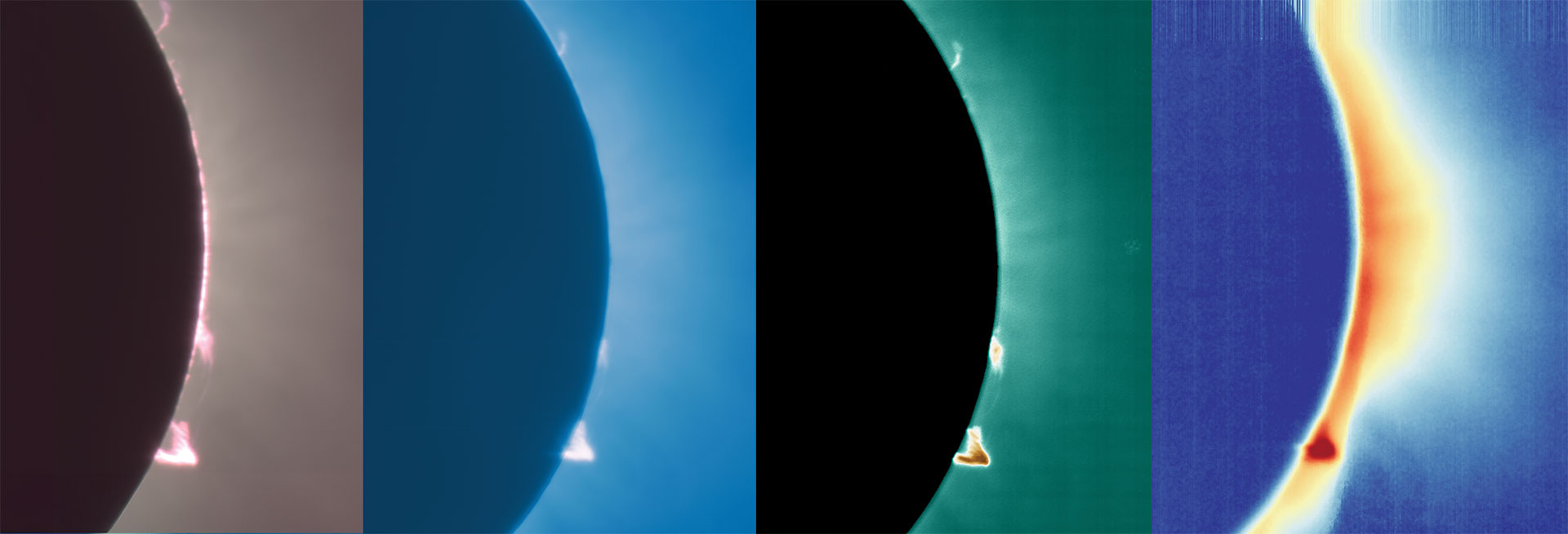
COURTESY SwRI / NASA / DAN SEATON /MATTHEW WEST
These preliminary images from a new suite of sensitive, high-speed, visible-light and infrared imagers aboard one of NASA’s WB-57 jets show the corona and prominences visible during the April 8 eclipse in four wavelength ranges. Moving forward, SwRI scientists will significantly improve the images through processing and analysis of the rich and complex data.
CATE 2024
CATE 2024 deployed a network of 35 teams of community participants, or “citizen scientists,” representing local communities along the eclipse path. Hundreds of CATE participants deployed a “bucket brigade” of small telescopes following the eclipse’s cross-country path from the Mexican to the Canadian borders.

From left, Bob Benedict, Theresa Costilow and Carlyn Rocazella celebrate getting their telescope, camera and computer equipment set to film the moments of totality from Site 25, a campground along Lake Erie
This experiment and the eclipse offered a bonding experience between scientists and communities along the path as the public donned and doffed eclipse glasses to experience a phenomenon that peoples throughout time have used to study the Sun and its mysteries.
This experiment follows the Citizen CATE 2017 experiment, which imaged the Aug. 21, 2017, event from coast to coast, using more than 60 teams of academics, school children and other volunteers. CATE 2017 was led by Dr. Matt Penn, who was then an astronomer with the National Solar Observatory in Tucson, Arizona. The project collected over 1 terabyte of white light images of the inner solar corona, creating a 90-minute, cross-country movie of the event.

When Hazel Wilkins, the CATE 24 northeast regional trainer, slipped off her eclipse glasses and the solar filter from the telescope, she was overcome with the sight of the total solar eclipse from the shore of Lake Champlain, near the New York-Vermont border.
CATE 2024’s next-generation scientific objectives required measuring the polarization of light, or the orientation of oscillating light waves, in the corona. Light behaves as a wave, like a string or the battle ropes in Crossfit that wave in a particular direction. Most people understand polarization based on the filters that block out light coming from a certain direction. Polarized sunglasses filter out light from a direction typically associated with glare.
The Citizen CATE 2024 cameras have a polarizing filter — little sunglasses — baked onto every pixel of the sensor, allowing them to measure four different angles of polarization everywhere in the corona, providing much more information than just measuring the brightness of the light.
The 2024 experiments are studying complex motion in the solar corona, at new wavelengths and with new polarization measurements, to help scientists understand why it is so hot.
Each team received a telescope, camera, computer and training to document the eclipse. The equipment is relatively new and only recently affordable, allowing CATE to create this distributed network across the U.S. The team beta tested the experiment taking the equipment and community volunteer leaders to Australia to observe an April 2023 total solar eclipse. They collected excellent data and demonstrated the ability to collect high dynamic range (HDR) images, where short exposures imaged the very bright elements and longer exposures collected dimmer light. The scientists then combined the data into one amazing image. They assigned a color to each of the polarization angles to create a rainbow image of the polarized light as well as the more intense white light solar prominences erupting from the surface of the Sun.
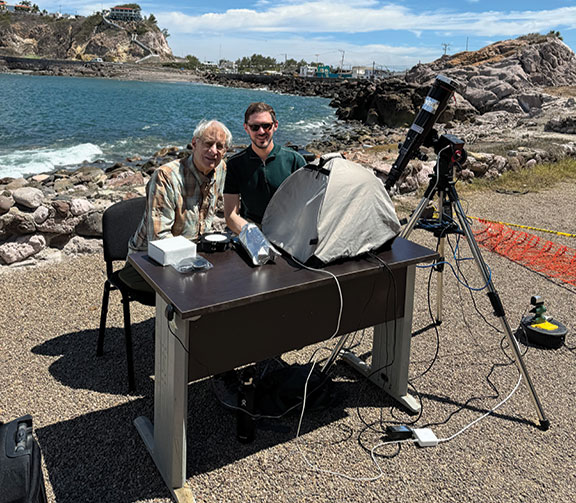
National Solar Observatory Astronomer Emeritus David Elmore and his son Chris used a CATE 2024 setup to gather eclipse data from first landfall of the total eclipse at Mazatlan, Mexico.

Students from the University of Indianapolis, or UINDY, collected CATE 2024 data from a site near Waynesfield, Ohio.
The images from these experiments are not just stunning but scientifically dense with data the scientists are still investigating. However, that is just one facet of the CATE experiment. By donating the equipment and training the citizen scientist volunteers, CATE invested in the communities along the path of totality, including many areas that are historically underrepresented or overburdened in terms of science education. Having the opportunity to engage in a scientific experiment like this provided transformative new experiences.
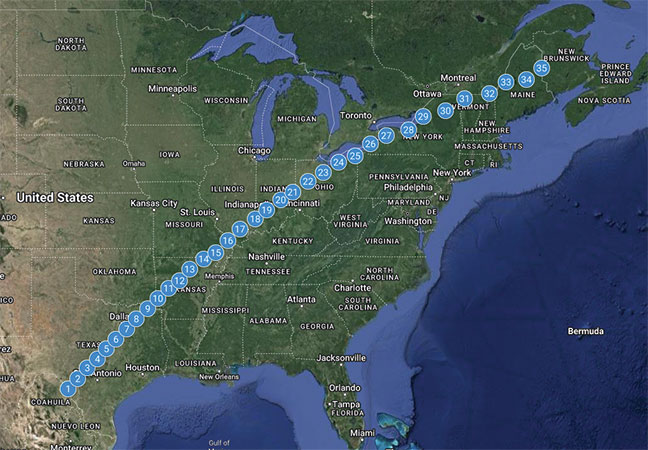
COURTESY CITIZEN CATE PROJECT
With 35 teams of local community participants, or “citizen scientists,” the Citizen Continental-America Telescopic Eclipse (CATE) 2024 project collected next-generation polarized observations during the 2024 total solar eclipse from Texas to Maine. The network of 35 telescopes may provide 60 continuous minutes of totality images. The CATE 2024 experiment addresses compelling open science questions that require the novel dataset provided by multi-point observations across the entire eclipse path.
For instance, SwRI’s project manager for CATE 2024, Sarah Kovac, started out on the CATE 2017 experiment as one of the community leaders. That inspired her to go into solar physics, get her graduate degree and then help lead the next-generation experiment with the next generation of citizen scientists. It shows the power of the community to do high-quality science, to observe one of the most amazing cosmic phenomena that can be seen with the naked eye.
Once the experiments were done, these communities kept the telescopes and auxiliary equipment to support future educational opportunities and community events.

COURTESY NASA/JAMES BLAIR
A new suite of sensitive, high-speed, visible-light and infrared imagers, built by the SCIFLI team at NASA’s Langley Research Center, were installed in the nose cone of one of NASA’s highflying WB-57 jets to observe the solar eclipse. SwRI will use the multispectral data to understand the physics behind the hot glow of various solar features.

The Site 31 team took a group shot, capturing a particularly awe-inspiring view of the eclipse.
AIRBORNE EXPERIMENTS
SwRI also led a 2024 airborne project to observe the corona during the eclipse from 50,000 feet. These high-altitude observations both provide measurements that can’t be made from the ground and avoid any weather-related risks. The team deployed a new suite of sensitive, high-speed, visible-light and infrared imagers, built by the SCIFLI team at NASA’s Langley Research Center, installed in the nose cone of a WB-57 jet.
This followed a 2017 experiment SwRI led using these unique aircraft, which have a wingspan of 122 feet. The aircraft have comparatively small bodies, allowing them to glide at high altitudes above 90% of the Earth’s atmosphere. In 2017, two NASA WB-57F research aircraft successfully tracked the solar eclipse to study the solar corona in the midwave infrared or thermal infrared. The stabilized telescopes used sensitive, high-speed, visible-light and infrared cameras to collect spectacular images, showing clear images of the Sun’s outer atmosphere.
The experiment discovered that various structures on the Sun glow in essentially equal brightness in this wavelength. However, these structures can differ in temperature by 100 times. For instance, solar prominences are only tens of thousands of degrees, but structures known as active regions are billions of degrees, so the physics of why they glow in infrared is different, but they glow equally bright.

Just south of the Canadian border in Pittsburg, Vermont, Site 32 enjoyed a full day of eclipse viewing activities. After setting up their CATE 2024 equipment, they used PUNCH pinhole projectors to view the eclipse indirectly as well as PUNCH sunglasses that show the polarized coronal light. A complementary SwRI-led mission, the Polarimeter to UNify the Corona and Heliosphere (PUNCH) mission will launch four suitcase-sized satellites into polar orbit in 2025 to study the solar corona with the goal of understanding the origin of the solar wind.
The 2024 experiment flew a new instrument package that uses four cameras equipped with an array of filters, to measure a range of wavelengths to get information across the color spectrum. The flight collected data from ultraviolet to visible light as well as near-infrared, short infrared and four different ranges of mid-infrared light to try and understand the physics of various types of brightly glowing structures.
The SwRI-led airborne team includes scientists from the National Center for Atmospheric Research High Altitude Observatory, NASA Langley Research Center, and Predictive Sciences Inc., with collaborators at the Smithsonian Astrophysical Observatory. The SwRI-led CATE 2024 project, funded by NSF and NASA, includes scientists from the National Center for Atmospheric Research, the National Solar Observatory, the Laboratory for Atmospheric and Space Physics at the University of Colorado, and the Space Science Institute, with collaborators at New Mexico State University and the Livelihoods Knowledge Exchange Network, community leaders at Rice University, Indiana University Bloomington, the University of Maine, and over 200 community participants in 35 communities along the eclipse path.
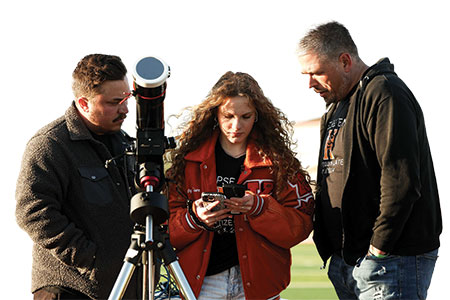
Kemp, Texas, a town of 1,200 less than 50 miles southeast of Dallas, assembled one of a few high school CATE 2024 teams, with seven students and two teachers. Just 90 seconds before totality, co-captain Katy Kiser followed her hunch to make final camera adjustments, as her teachers Billy House (left) and Kyle Rimler let her take the lead. And CATE 2024 Site 7 collected perfectly centered, focused images.
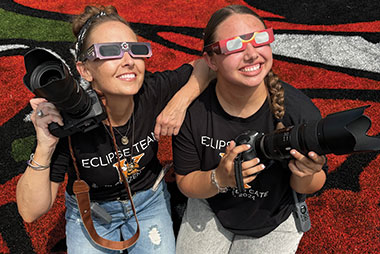
In support of the Kemp high school CATE 2024 team, the school district organized a “Solar Bowl” flag football game including drill, cheer and band performances in addition to observing the eclipse.

ABOUT THE AUTHOR
Dr. Amir Caspi (right) is an experimental solar astrophysicist specializing in high-energy solar events and the solar corona. He is the principal investigator of the CATE 2024 experiment and observations of the solar corona from aboard NASA’s WB-57 aircraft for the recent total solar eclipse. Dr. Dan Seaton is a solar physicist who specializes in observing and modeling the inner and middle solar corona. He serves as the science lead on the two projects above and is the deputy principal investigator of a proposed solar mission observing the middle corona in extreme ultraviolet wavelengths. Caspi and Seaton demonstrated CATE 2024 telescopes during the October 2023 annular eclipse from Loveland Pass in Colorado.
The authors would like to acknowledge the leadership of Sarah Kovac, who played a key role in CATE 2024’s success, as well as the assistance of Willow Reed and the Laboratory for Atmospheric and Space Physics. The authors also thank the Citizen CATE 2024 site teams for sharing their photographs.
Questions about this story or Heliophysics. Contact Amir Caspi, Ph.D, at +1 303 546 6351 or Dan Seaton, Ph.D. at +1 720 240 0109

